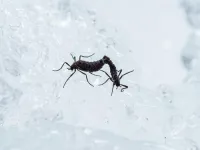Can math save content creators? A new model proposes fairer revenue distribution methods for streaming services
Researchers at the Universidad Miguel Hernández (UMH) in Spain have developed a mathematical model with three rules designed to improve revenue sharing on streaming platforms.
2025-02-12
(Press-News.org)
As more consumers turn to subscription-based platforms, the distribution of revenue in streaming services has become a crucial issue in the digital economy. Content creators and artists argue that the current models are opaque, frequently neglecting the needs of creators. In response, researchers at UMH have proposed a model based on three allocation rules that could be applied according to various fairness criteria.
"Our model is based on three main approaches: the equal division rule, which divides revenue equally among services; the proportional rule, which allocates revenue according to each service's total consumption; and the subscriber-proportional rule, which assigns a subscriber's fee based on their specific consumption," explains UMH Professor Juan Carlos Gonçalves Dosantos, a researcher at the Institute Center for Operational Research.
The challenge of distributing profits between creators and platforms is not unique to major services like Netflix and Spotify but also affects emerging platforms. Revenue structures in streaming—based on subscriptions, advertisements, and additional paid content—vary depending on each platform's business model. For example, Twitch generates revenue from subscriptions to streamers' channels, advertisements, donations, and the sale of virtual units like "Bits." This diversity of income sources and the complexity of user-creator interactions makes revenue distribution challenging. The UMH researchers have used mathematical models to explore how these profits can be fairly allocated based on different criteria.
Professor Joaquín Sánchez Soriano of UMH explains that the models allow for an analysis of how different types of content impact overall revenue: "On platforms like Twitch, we see that the type of content directly influences revenue. Our study shows that categories with fewer users but greater viewing time can be more lucrative under a proportional approach. On the other hand, the subscriber-proportional rule prioritizes categories that attract more viewers, regardless of viewing time."
The UMH study, published in the scientific journal Omega and conducted in collaboration with a researcher from the University of Granada, establishes clear guidelines for revenue distribution, which can help creators maximize their earnings and enable platforms to optimize their business models. "Our tool helps evaluate which content is more profitable and guides creators in adjusting their offerings to boost income," adds Sánchez Soriano.
The mathematical model developed at UMH is based on the concept of attribution problems, which aim to distribute resources (in this case, generated revenue) fairly among different services according to the number of subscribers and their consumption. "Each service is entitled to a share of the revenue based on its relevance and consumption, which presents a challenge due to the variety of content and its different impact on users," notes Gonçalves Dosantos.
To illustrate its operation, Gonçalves Dosantos provides an example: "Consider a streaming platform offering two products with two subscribers. Both pay the same subscription fee, but their usage differs. The first subscriber dedicates an hour exclusively to the first product, while the second watches one hour of each product."
Under the equal division rule, the revenue would be split equally, assigning 50% to each service regardless of viewing time. The proportional rule, which accounts for time, would allocate 67% of the revenue to the first service and 33% to the second. Finally, the subscriber-proportional rule, in addition to time, takes into account which product each subscriber consumes, assigning 75% of the revenue to the first product and 25% to the second.
This innovative approach could lead to a fairer distribution of profits, providing a clearer understanding of the economic dynamics in streaming services. By applying these mathematical models, platforms could improve transparency in revenue distribution, a crucial step in maintaining balanced relationships with creators. The UMH researchers argue that this would promote a greater diversity of voices and support the sustainability of digital businesses.
END
ELSE PRESS RELEASES FROM THIS DATE:
2025-02-12
A collaboration of researchers from Colorado State University and Denver Zoo Conservation Alliance surveyed zoo employees and volunteers across the US about their experiences of burnout and grief related to zoo animal losses.
Their latest study has found that poor grief support in some US zoos leaves staff feeling limited empathy from leadership, burned out, and unable to openly express their grief after the death of an animal to which they had formed a close emotional bond.
The research, published in the journal ...
2025-02-12
ANN ARBOR, Mich. — A cardiac surgery and heart failure team at the University of Michigan implanted a novel mechanical heart pump into a patient as part of a clinical trial that will compare it to the only device currently used to treat end-stage heart failure.
“This trial presents an opportunity to assess novel technology as we explore a potential new treatment for advanced heart failure — a life-threatening condition with extremely limited therapeutic opportunities available,” said Francis Pagani, M.D., Ph.D., national ...
2025-02-12
Picture an Antarctic animal and most people think of penguins, but there is a flightless midge, the only known insect native to Antarctica, that somehow survives the extreme climate. How the Antarctic midge (Belgica antarctica) copes with freezing temperatures could hold clues for humans about subjects like cryopreservation, but there remain many mysteries about the tiny insect.
One mystery appears to have been solved by an Osaka Metropolitan University-led international research team. Graduate School of Science Professor Shin G. Goto and Dr. Mizuki Yoshida, a graduate student at the time of the research who is now a postdoc at Ohio State University, found ...
2025-02-12
A new study explores how complex chemical mixtures change under shifting environmental conditions, shedding light on the prebiotic processes that may have led to life. By exposing organic molecules to repeated wet-dry cycles, researchers observed continuous transformation, selective organization, and synchronized population dynamics. Their findings suggest that environmental factors played a key role in shaping the molecular complexity needed for life to emerge. To simulate early Earth, the team subjected chemical mixtures to repeated wet-dry cycles. Rather than reacting randomly, the molecules organized themselves, evolved over time, and followed predictable patterns. This challenges ...
2025-02-12
Global aviation carbon dioxide emissions increased by 1% in 2023 because planes had to fly longer routes to avoid Russian airspace, according to a new study.
After Russia invaded Ukraine in February 2022, Western airlines were banned from flying over Russia. This forced them to take much longer routes between Europe or North America and East Asia, burning more fuel in the process.
Published today (Wednesday, 12 February) in Communications Earth & Environment, the study found that detours caused by the Ukraine war led to planes using 13% more fuel on average compared to their original routes. The impact was even greater for flights between Europe and Asia, which saw a 14.8% increase in ...
2025-02-12
For the first time, scientists have demonstrated that negative refraction can be achieved using atomic arrays - without the need for artificially manufactured metamaterials.
Scientists have long sought to control light in ways that appear to defy the laws of Nature.
Negative refraction - a phenomenon where light bends in the opposite direction to its usual behaviour - has captivated researchers for its potential to revolutionise optics, enabling transformative technologies such as superlenses and cloaking devices.
Now, carefully ...
2025-02-12
Research Highlights:
A data analysis projected that South Asian adults living in the United Kingdom may experience elevated blood pressure nine years earlier than East Asian adults on average.
The largest blood pressure disparities between South Asian and East Asian adults were projected to be in 18-39-year-old men and 40–64-year-old women.
The projected increase in systolic blood pressure in middle age East Asian adults was linked to a nearly 2.5 times higher risk for heart disease caused by blocked arteries and a nearly fourfold greater risk of stroke. Even at an older age, high systolic ...
2025-02-12
Take a look around your home and you’ll find yourself surrounded by familiar comforts—photos of family and friends on the wall, well-worn sneakers by the door, a shelf adorned with travel mementos.
Objects like these are etched into our memory, shaping who we are and helping us navigate environments and daily life with ease. But how do these memories form? And what if we could stop them from slipping away under a devastating condition like Alzheimer’s disease?
Scientists at UBC’s faculty of medicine have ...
2025-02-12
Australian scientists have found an effective new way to clean up methylmercury, one of the world’s most dangerous pollutants, which often builds up in our food and environment because of industrial activities such as illegal gold mining and burning coal. The discovery, published in Nature Communications on 12 February 2025, could lead to new ways of engineering animals to protect both wildlife and human health.
The research team from Macquarie University's Applied BioSciences, CSIRO, Macquarie Medical School, and the ARC Centre of Excellence in Synthetic Biology, has successfully genetically modified fruit flies and zebrafish to transform methylmercury into a ...
2025-02-12
New study reveals that coral reefs in the Gulf of Eilat experienced a surprising 3,000-year "shutdown" in growth, from about 4,400 to 1,000 years ago, likely due to a temporary drop in sea level that could have been caused by global cooling. This phenomenon, which aligns with similar reef interruptions in Mexico, Brazil, and Australia, suggests a widespread environmental shift during that period. Despite the long pause, the reef eventually recovered, with coral species reappearing from deeper ...
LAST 30 PRESS RELEASES:
[Press-News.org] Can math save content creators? A new model proposes fairer revenue distribution methods for streaming services
Researchers at the Universidad Miguel Hernández (UMH) in Spain have developed a mathematical model with three rules designed to improve revenue sharing on streaming platforms.



